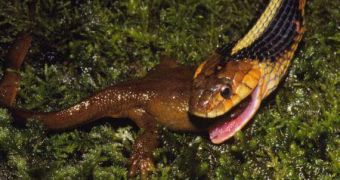Newts and salamanders may look cute and helpless, but you'd be surprised to know that they produce one of the most powerful toxins for protection in the amphibian world. Still, the common garter snakes (Thamnophis sirtalis) of North America indulge in rough-skinned newts (Taricha granulosa), considered the most poisonous amphibians in the world: the venom of just one animal, 12 to 22 cm (5-9 in) long can kill 12 people. The poison is tetrodotoxin (TTX), the same neurotoxin encountered in blowfish and used in Voodoo rites, which paralyzes breath muscles and stops the heart.
The mystery was solved by a new research published in the journal PloS Biol: garter snakes along the west coast of North America solved their conflict with the Taricha newts via a single mutation.
The team led by Charles Hanifin of Stanford University, California, US, assessed the toxicity of 383 rough-skinned newts at 28 sites from British Columbia to central California.
"Ounce for ounce, some of these populations are the most toxic amphibians on the planet," said Hanifin.
The TTX levels in the skin of the newts were compared with the resistance of local garter snakes. Locally, the snakes' degree of resistance fitted the newt toxicity; TTX temporarily benumbed the snakes , but it did kill them. This shows a close "arms race" between the newt toxicity and snake resistance. A benumbed snake can pay a price, as it experiences a period when it can be easily caught by its predators.
But in some populations, the snake was totally victorious, as TTX had no measurable effect on its motor capacity. A single mutation on TTX receptor protein located on the surface of their neural and muscle cells impeded TTX to bind to these cells, turning the snakes totally immune.
"It is pretty much biologically impossible for the newts to ever catch up," said Hanifin.
While the snake got its immunity with one mutation, higher toxicity of the poison requires more mutations. Snakes can cope with toad poison, too
A 2007 study showed how a physiological mechanism allows non-venomous snakes to use the venom of their preys to ward off predators. This was previously known for vertebrates only in toxic frogs from Madagascar and tropical America that take toxins from their invertebrate preys.
The toad-eating Japanese tiger keel back snake (Rhabdophis tigrinus) store toad toxins in their neck glands. When the snake is attacked, it releases the toad poisons from these neck glands.
The toxic sequestration is much more common amongst invertebrates, especially among insects which eat venomous plants (many caterpillars are notorious, and even pass the venom to the adult phase as butterflies!) and sea slugs eating poisonous anemones.
As in the case of frogs, the toxin amounts in the snakes' neck glands was linked to their access to toxic prey. Snakes devoid of the borrowed toxins were less likely to hold on and display a toxin-releasing defensive behavior. The toxins are stored by a specialized neck gland. Toads' venom provokes eye and mouth irritation, psychoactive effects, and neurotoxic effects, translated into paralysis and even cardiac arrest and breathing failure.

 14 DAY TRIAL //
14 DAY TRIAL //